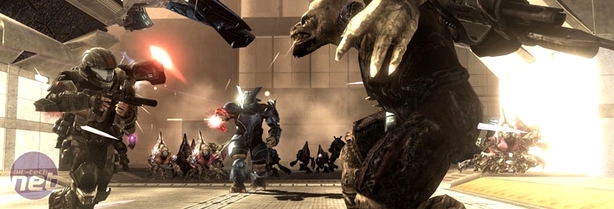
Finish the Firefight
Nevermind all that singleplayer nonsense though – the multiplayer side of things are what a lot of Xbox 360 gamers are going to be mainly interested. There’s good news on that front as well, as ODST not only introduces new multiplayer options but also brings with it a fair bit of value for money.Obviously, there’s all the usual co-operative play options, with ODST supporting up to four players, even though that does take away some of the thrill of being stranded alone in New Mombasa. On top of that though there’s also the new co-op mode, Firefight.
Ostensibly, Firefight isn’t anything truly new – it’s yet another variation of that ‘wave of enemies’ archetype that’s also called Survival in Left 4 Dead or Horde in Gears of War 2. What sets it apart a little though is the fact that Bungie has given it a bit of a twists via the skulls feature, which progressively alter the gameplay.
For those not in the know, ‘skulls’ are hidden items which have appeared in the previous Halo games which are notoriously hard to find and also alter the gameplay when you collect them. In Firefight mode though they are featured as a checklist on the left side of the screen, turning on or off as the game draws on and you try to survive the next wave of Covenant monsters before your squad is totally wiped out.
The result is an already tense game mode made even more butt-clenchingly stressful as the announcer tells you that the Black Eye skull has now been turned on and the only way to recover health is melee an enemy to death. Mixing it up even more is the fact that the individual waves of enemies are completely random and unlimited in number, meaning that you’re unable to form established tactics for each attack and the game becomes not a matter of surviving, but moving slowly closer to the inevitable finish. It makes for a fantastic team-play experience with pals – especially if you’ve just finished the co-op campaign and unlocked all the Firefight levels.
It’s worth mentioning that even though Halo 3: ODST is supposedly either an expansion or a fully-fledged retail game in its own right, it has been padded out with a second disc of multiplayer goodies. If you’re a casual acolyte of Halo and have already got a copy of Halo 3 then it’s not anything worth getting really in a twist over, but if you missed out on the last game or have a deep need to collect everything Bungie has touched then it’s definitely worth a look. The second disc contains the entire multiplayer segment of Halo 3.
 It’s a complete collection too – including all the expansion map packs and all the original content from Halo 3, as well as three new maps to help those of you who already own Halo 3 avoid the feeling that you’ve bought the same content twice. Essentially though, you have, and the short length of Halo 3: ODST as well as the story of how it may have been a little rushed out may make that a bit of a sore point. As a retail product ODST really is an expansion campaign disguised as a retail product, but there’s still plenty of play value in it.
It’s a complete collection too – including all the expansion map packs and all the original content from Halo 3, as well as three new maps to help those of you who already own Halo 3 avoid the feeling that you’ve bought the same content twice. Essentially though, you have, and the short length of Halo 3: ODST as well as the story of how it may have been a little rushed out may make that a bit of a sore point. As a retail product ODST really is an expansion campaign disguised as a retail product, but there’s still plenty of play value in it. The main disappointment then is the simple fact that there’s nothing truly new or interesting in ODST – in many ways it really is just Halo with a blank, new character replacing the legendary Master Chief. For all our back and forth on the story and the way it keeps you playing with its unanswered questions, it’s hard to escape the fact that it’s not as truly a gripping experience as any of the previous game. Likewise, from a mechanical point of view, there’s nothing here that hasn’t been done elsewhere in the series. The multiplayer and co-op modes are, as ever, going to be the main draw for a lot of people and they’re still remarkably solid, just not solidly remarkable.
Score Guide

MSI MPG Velox 100R Chassis Review
October 14 2021 | 15:04











Want to comment? Please log in.